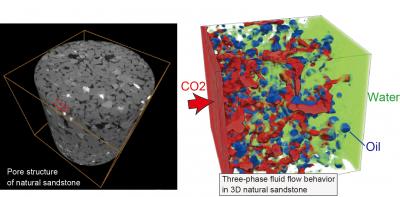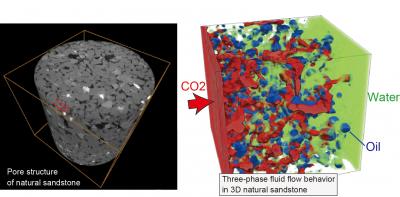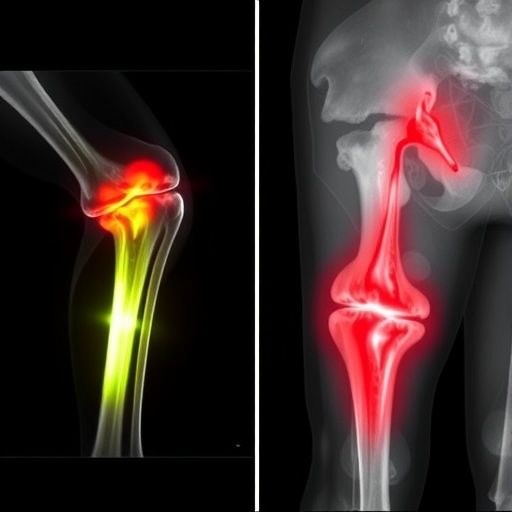
Credit: Water Resources Research
Fukuoka, Japan – A potential solution for addressing climate change is to securely store carbon dioxide underground in reservoirs from which oil was previously extracted, an approach known as carbon sequestration. This is expensive, but the costs can be reduced by extracting any remaining oil from these reservoirs at the same time as introducing the carbon dioxide. However, it has been difficult to determine the most appropriate sites in terms of retaining the carbon dioxide for a long time as well as maximizing the recovery of oil.
Research from the International Institute for Carbon Neutral Energy Research (I2CNER) at Japan's Kyushu University has now developed a method of simulating a high-pressure mixture of oil, carbon dioxide, and water underground and the extent that it permeates rock, based on images of the rock structure taken at the microscopic level. This approach should help in identifying appropriate sites for applying this technology, thereby increasing the amount of carbon dioxide that can be sequestered and helping impede climate change.
For carbon sequestration at sites of spent oil reservoirs, carbon dioxide is injected at such a high pressure that it adopts a fluid-like form called supercritical fluid. There are thus three "fluids": carbon dioxide, water, and oil, at these underground sites, so it is difficult to model their complex behavior. In their study, the researchers used a model called the three-phase lattice-Boltzmann model to predict what will happen to these liquids during carbon sequestration, considering factors such as the size and shapes of empty "pores" within the rock and the levels of saturation of these fluids in the rock. This approach further provides the three-phase relative permeability of natural rocks, although laboratory measurements of this are extremely complicated, costly, and time-consuming.
"In carbon sequestration, we can redirect carbon dioxide from sites of major production such as power plants to underground reservoirs, where it should remain for thousands of years," study coauthor Takeshi Tsuji says. "Our method can tell us which storage sites would be best for this. It does this by revealing how much carbon dioxide and oil will pass through the rock at a particular site."
Tsuji and author Fei Jiang confirmed the accuracy of this method by testing it with a 3D image of the microstructure of sandstone. The simulation involved setting initial conditions with oil and water present at different levels in the rock, followed by the injection of carbon dioxide at high pressure, after which the changes in the distributions of these three components were predicted. Previous studies were unable to perform such three-phase fluid flow simulation in 3D natural sandstone; therefore this successful simulation in natural rock is an exciting achievement.
"The accuracy of the results of our method is very important," Jiang says. "If carbon sequestration practitioners make wrong calculations and choose inappropriate sites, carbon dioxide cannot pass through the rock, and fractures could appear in the rock after the high-pressure injection, which might lead to dangerous emissions at the surface or trigger earthquakes."
By improving the efficiency of oil extraction and thus increasing the profitability of this form of carbon sequestration, this method should enable this form of carbon capture to be performed more widely.
The article "Estimation of three-phase relative permeability by simulating fluid dynamics directly on rock-microstructure images" was published in Water Resources Research at DOI: 10.1002/2016WR019098.
###
Media Contact
Sayaka Ao
[email protected]
############
Story Source: Materials provided by Scienmag





